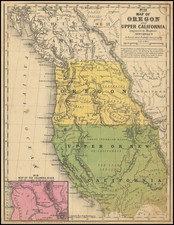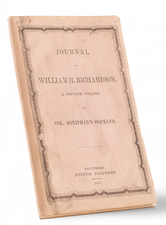Celebrating the Boy Scouts of America Scout Ranch in New Mexico
Pictorial map of the Philmont Scout Ranch by A.B. Hirschfield in Denver.
The map is adopted from a US Geological Survey topographical map, embellished with color and western illustrations.
Philmont Scout Ranch
The Philmont Scout Ranch is a ranch located near the town of Cimarron, New Mexico covering approximately 219 square miles of wilderness in the Sangre de Cristo Mountains of the Rocky Mountains. Donated by oil baron Waite Phillips in 1938, the ranch is owned and operated by the Boy Scouts of America. It is a National High Adventure Base where crews of Scouts and Venturers take part in backpacking treks and other outdoor activities. By land area, it is one of the largest youth camps in the world. During the season, between June 8 and August 22, an estimated 22,000 Scouts and adult leaders backpack through the Ranch's extensive backcountry. More than 1,130 seasonal staff are responsible for the Ranch's summer operations.
The Santa Fe Trail crossed the plains just southwest of Philmont in the mid-1800s. The Tooth of Time owes its name to this trail; travelers knew that once they passed it, they had only one week to go until they reached Santa Fe, New Mexico. Philmont's strategic location along the trail spurred some interest in it. In 1841, Carlos Beaubien and Guadalupe Miranda obtained a large land grant from the Mexican government, including the present ranch. Soon the grant fell into the hands of Beaubien's son-in-law Lucien Maxwell, who played an important role in developing and settling it. Maxwell sold the ranch to the Maxwell Land Grant and Railroad Company, which gave up and handed it on to a Dutch development company, which decided to parcel it out to ranchers.
One of the most prominent ranchers was Jesus Gil Abreu, who ran the Abreu Rayado Ranch from the 1870s to his death in 1901. Operating from the Rayado Settlement, he raised cattle, goats, and sheep and grew crops. The family owned this property until 1911, when they sold most of it off. One of the sons remained on the ranch near the site of Abreu, a present staffed camp, and his homestead was preserved for years. The building was made of adobe, was abandoned and eventually collapsed. The foundation of this building now serves as the foundation for the Abreu cantina. The house was reconstructed in 1998 about 100 feet (30 m) uphill.
The history of mining at Philmont dates back to the years immediately after the Civil War. U.S. soldiers were stationed in the West after the war, as the U.S. Army was driving out the American Indians. The story is that one of these soldiers befriended an Indian, who happened to give him a shiny rock. The shiny material in the rock was found to be copper. According to the story, the soldier and two of his friends went up to investigate, and found gold. They could not stay to mine the gold and the area was overrun by miners by the time they returned the next year. Scores of gold mines were excavated in Philmont, and operated into the early 20th century. A large vein of gold is said to lie under Mount Baldy to this day, but extracting it has not been feasible. It is a common joke at Philmont that some day the mines under Baldy will collapse and Phillips will be the highest mountain in Philmont. The Contention Mine, located at Cyphers Mine, and the Aztec Mine, located at French Henry, are open to guided tours.
Wealthy oil magnate and wilderness enthusiast Waite Phillips amassed a large part of the old land grant in the 1920s, totaling over 300,000 acres. Phillips built a large residence in the lowlands of Philmont. He turned the ranch into a private game reserve for himself and friends, and built a number of hunting lodges and day-use camps. He chose not to provide electricity at the remote camps. A few of these original camps, including Fish Camp and the Hunting Lodge, have been preserved, complete with wood-burning stoves, oil lamps, and unique design features indicative of Phillips's often eccentric taste.
Phillips sometimes allowed others, including a few Boy Scout troops, to visit his ranch. He was so impressed with the Scouts that in 1938, during the Great Depression, he donated 35,857 acres of his land to the Boy Scouts of America. His only condition was that the property be used "for the benefit of the members of the Boy Scout organization". He donated a second, larger section of land later in the 1930s, requiring only that this section pay its fair share of taxes on any portion devoted to competitive commercial operations.
Albert Hirschfeld (June 21, 1903 – January 20, 2003) was an American caricaturist best known for his black and white portraits of celebrities and Broadway stars.
Born in St. Louis, Missouri, Albert Hirschfeld moved with his family to New York City, where he received his art training at the Art Students League of New York.
n 1924, Hirschfeld traveled to Paris and London, where he studied painting, drawing and sculpture. When he returned to the United States, a friend, fabled Broadway press agent Richard Maney, showed one of Hirschfeld's drawings to an editor at the New York Herald Tribune, which got Hirschfeld commissions for that newspaper and then, later, The New York Times.
Hirschfeld's style is unique, and he is considered to be one of the most important figures in contemporary drawing and caricature, having influenced countless artists, illustrators, and cartoonists. His caricatures were regularly drawings of pure line in black ink, for which he used a genuine crow quill.
Readers of The New York Times and other newspapers prior to the time they printed in color will be most familiar with the Hirschfeld drawings that are black ink on white illustration board. However, there is a whole body of Hirschfeld’s work in color. Hirschfeld’s full-color paintings were commissioned by many magazines, often as the cover. Examples are TV Guide, Life Magazine, American Mercury, Look Magazine, The New York Times Magazine, The New Masses, and Seventeen Magazine. He also illustrated many books in color, most notably among them Harlem As Seen By Hirschfeld, with text by William Saroyan.
Hirschfeld started young and continued drawing to the end of his life, thus chronicling nearly all the major entertainment figures of the 20th century. During his eight-decade career, he gained fame by illustrating the actors, singers, and dancers of various Broadway plays, which would appear in advance in The New York Times to herald the play's opening. Though the theater was his best-known field of interest, according to Hirschfeld's art dealer Margo Feiden, he actually drew more for the movies than he did for live plays. "By the ripe old age of 17, while his contemporaries were learning how to sharpen pencils, Hirschfeld became an art director at Selznick Pictures. He held the position for about four years, and then in 1924 Hirschfeld moved to Paris to work and lead the Bohemian life. Hirschfeld also grew a beard, necessitated by the exigencies of living in a cold water flat. This he retained for the next 75 years, presumably because "you never know when your oil burner will go on the fritz."
In addition to Broadway and film, Hirschfeld also drew politicians, TV stars, and celebrities of all stripes from Cole Porter and the Nicholas Brothers to the cast of Star Trek: The Next Generation. He also caricatured jazz musicians— Glenn Miller, Duke Ellington, Count Basie, Dizzy Gillespie, Billie Holiday, and Ella Fitzgerald—and rockers The Beatles, Elvis Presley, Bruce Springsteen, Bob Dylan, Jerry Garcia, and Mick Jagger. In 1977 he drew the cover of Aerosmith's Draw the Line album.
Hirschfeld drew many original movie posters, including for Charlie Chaplin's films, as well as The Wizard of Oz (1939). The "Rhapsody in Blue" segment in the Disney film Fantasia 2000 was inspired by his designs, and Hirschfeld became an artistic consultant for the segment; the segment's director, Eric Goldberg, is a longtime fan of his work. Further evidence of Goldberg's admiration for Hirschfeld can be found in Goldberg's character design and animation of the genie in Aladdin (1992). He was the subject of the Oscar-nominated documentary film, The Line King: The Al Hirschfeld Story (1996).
Al Hirschfeld famously contributed to The New York Times for more than seven decades. His work also appeared in The New York Herald Tribune, The Old World, The New Yorker Magazine, Collier's, The American Mercury, TV Guide, Playbill, New York magazine, and Rolling Stone.
In 1941, Hyperion Books published Harlem As Seen By Hirschfeld, with text by William Saroyan.[12]
Hirschfeld's illustrations for the theater were gathered and published yearly in the books, The Best Plays of ... (for example, The Best Plays of 1958-1959).[13]
Additional collections of Hirschfeld's illustrations include: Manhattan Oasis, Show Business Is No Business (1951), American Theater, The American Theater as Seen by Al Hirschfeld, The Entertainers (1977), Hirschfeld by Hirschfeld (1979), The World of Al Hirschfeld (1970), The Lively Years, 1920-1973 with text by Brooks Atkinson, Hirschfeld’s World (1981), Show Business is No Business with preface and endnotes by Margo Feiden (1983), A Selection of Limited Edition Etchings and Lithographs with text by Margo Feiden (1983), Art and Recollections From Eight Decades (1991), Hirschfeld On Line (2000), Hirschfeld’s Hollywood (2001), Hirschfeld’s New York (2001), Hirschfeld’s Speakeasies of 1932 with Introduction by Pete Hamill (2003), and Hirschfeld’s British Isles (2005).
Hirschfeld collaborated with humorist S. J. Perelman on several publications, including Westward Ha! Or, Around the World in 80 Clichés, a satirical look at the duo's travels on assignment for Holiday magazine. In 1991, the United States Postal Service commissioned him to draw a series of postage stamps commemorating famous American comedians. The collection included drawings of Stan Laurel, Oliver Hardy, Edgar Bergen (with Charlie McCarthy), Jack Benny, Fanny Brice, Bud Abbott, and Lou Costello. He followed that with a collection of silent film stars including Rudolph Valentino, ZaSu Pitts and Buster Keaton. The Postal Service allowed him to include Nina's name in his drawings, waiving their own rule forbidding hidden messages in United States stamp designs.
Hirschfeld expanded his audience by contributing to Patrick F. McManus' humor column in Outdoor Life magazine for a number of years.
Permanent collections of Hirschfeld's work are in the Metropolitan Museum of Art and the Museum of Modern Art in New York.
A permanent collection at the Margo Feiden Galleries Ltd. includes seventy-five years of Hirschfeld's original drawings, limited edition lithographs and etchings, and archives.
The Martin Beck Theatre, which opened November 11, 1924, at 302 West 45th Street, was renamed to become the Al Hirschfeld Theatre on June 21, 2003. It reopened on November 23, 2003, with a revival of the musical Wonderful Town. Hirschfeld was also honored with a star on the St. Louis Walk of Fame.
In 2002, Al Hirschfeld was awarded the National Medal of Arts. He was an Honorary Member of the Salmagundi Club.









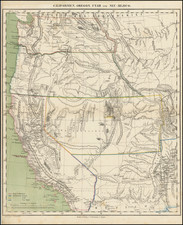
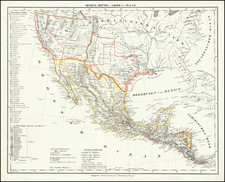
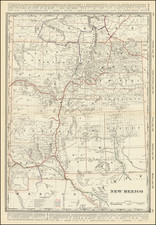
![[ Texas - Chihuahua ] Santiago Mountains (470) World Aeronautical Chart](https://storage.googleapis.com/raremaps/img/small/96897.jpg)
